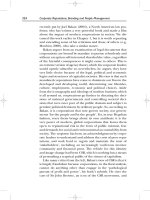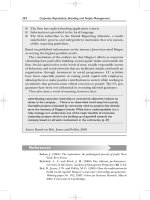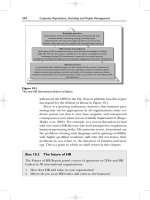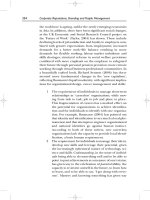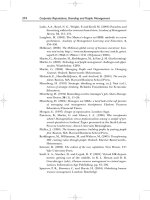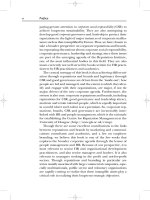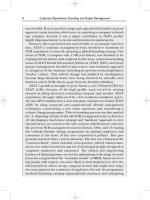Minds, bodies and people
Bạn đang xem bản rút gọn của tài liệu. Xem và tải ngay bản đầy đủ của tài liệu tại đây (202.07 KB, 31 trang )
2
Minds, bodies and people
A perennial issue in the philosophy of mind has been the
so-called mind–body problem: the problem of how the mind is
related to the body. However, as I indicated in the previous
chapter, this way of putting the problem is contentious, since
it suggests that ‘the mind’ is some sort of thing which is some-
how related to the body or some part of the body, such as the
brain. We are invited to consider, thus, whether the mind is
identical with the brain, say, or merely causally related to it.
Neither proposal seems very attractive – the reason being, I
suggest, that there is really no such thing as ‘the mind’.
Rather, there are minded beings – subjects of experience –
which feel, perceive, think and perform intentional actions.
Such beings include human persons, such as ourselves, who
have bodies possessing various physical characteristics, such
as height, weight and shape. The mind–body problem,
properly understood, is the problem of how subjects of experi-
ence are related to their physical bodies.
Several possibilities suggest themselves. In describing
them, I shall restrict myself to the case of human persons, while
recognising that the class of subjects of experience may be
wider than this (because, for instance, it may include certain
non-human animals). One possibility is that a person just is –
that is, is identical with – his or her body, or some distingu-
ished part of it, such as its brain. Another is that a person is
something altogether distinct from his or her body. Yet
another is that a person is a composite entity, one part of
which is his or her body and another part of which is some-
thing else, such as an immaterial spirit or soul. The latter
8
Minds, bodies and people 9
two views are traditionally called forms of ‘substance dual-
ism’. A ‘substance’, in this context, is to be understood, quite
simply, as any sort of persisting object or thing which is capable
of undergoing changes in its properties over time. It is
important not to confuse ‘substance’ in this sense with ‘sub-
stance’ understood as denoting some kind of stuff, such as
water or iron. We shall begin this chapter by looking at some
arguments for substance dualism.
CARTESIAN DUALISM
Perhaps the best-known substance dualist, historically, was
Rene
´
Descartes – though it is not entirely clear which of the
two forms of substance dualism mentioned above he adhered
to.
1
Often he writes as if he thinks that a human person, such
as you or I, is something altogether distinct from that per-
son’s body – indeed, something altogether non-physical, lack-
ing all physical characteristics whatever. On this interpreta-
tion, a human person is an immaterial substance – a spirit
or soul – which stands in some special relation to a certain
physical body, its body. But at other times he speaks more as
if he thinks that a human person is some sort of combination
of an immaterial soul and a physical body, which stand to one
another in a rather mysterious relation of ‘substantial union’.
I shall set aside this second interpretation, interesting
though it is, largely because when philosophers today talk
about ‘Cartesian dualism’ they usually mean the former view,
according to which a person is a wholly immaterial substance
1
Descartes’s views about the relationship between self and body receive their best-
known formulation in his Meditations on First Philosophy (1641), to be found in The
Philosophical Writings of Descartes, ed. J. Cottingham, R. Stoothoof and D. Murdoch
(Cambridge: Cambridge University Press, 1984). In recent times, one of Descar-
tes’s best-known and severest critics has been Gilbert Ryle: see his The Concept of
Mind (London: Hutchinson, 1949), ch. 1. For a controversial critique of the
received view that Descartes was a ‘Cartesian dualist’, see Gordon Baker and
Katherine J. Morris, Descartes’ Dualism (London: Routledge, 1996). It is unfortu-
nate that many modern philosophers of mind tend to distort or oversimplify the
historical Descartes’s views, but this is not the place for me to engage with them
over that issue.
An introduction to the philosophy of mind10
possessing mental but no physical characteristics. But it is
important, when considering this view, not to confuse the
term ‘substance’ in the sense in which we have just been
using it with the sense in which it denotes a kind of stuff.
Cartesian dualism does not maintain that a person is, or is
made of, some sort of ghostly, immaterial stuff, such as the
‘ectoplasm’ beloved of nineteenth-century spiritualists. On
the contrary, it maintains that a person, or self, is an alto-
gether simple, indivisible thing which is not ‘made’ of any-
thing at all and has no parts. It contends that you and I are
such simple things and that we, rather than our bodies or
brains, are subjects of experience – that is, that we rather
than our bodies or brains have thoughts and feelings. In fact,
it contends that we and our bodies are utterly unlike one
another in respect of the sorts of properties that we possess.
Our bodies have spatial extension, mass, and a location in
physical space, whereas we have none of these. On the other
hand, we have thoughts and feelings – states of con-
sciousness – whereas our bodies and brains lack these alto-
gether.
What reasons did Descartes have for holding this seem-
ingly strange view of ourselves – and how good were his
reasons? He had several. For one thing, he considered that
our bodies were simply incapable of engaging in intelligent
activity on their own account – incapable of thinking. This
is because he believed that the behaviour of bodies, left to
themselves, was entirely governed by mechanical laws, deter-
mining their movements as the effects of the movements of
other bodies coming into contact with them. And he couldn’t
see how mechanically determined behaviour of this sort could
be the basis of such manifestly intelligent activity as the
human use of speech to communicate thoughts from one
person to another. With the benefit of hindsight, we who live
the age of the electronic computer may find this considera-
tion less than compelling, because we are familiar with the
possibility of machines behaving in an apparently intelligent
fashion and even using language in a way which seems to
resemble our own use of it. Whether it is right to think of
Minds, bodies and people 11
computers as really being capable of intelligent behaviour on
their own account, or merely as cleverly constructed devices
which can simulate or model intelligent behaviour, is an open
question, to which we shall return in chapter 8. But, cer-
tainly, there is no simple and obvious argument from our own
capacity for intelligent behaviour to the conclusion that we
are not to be identified with our bodies or brains.
THE CONCEIVABILITY ARGUMENT
The argument that we have just considered and found want-
ing is an empirical argument, at least to the extent that it
appeals in part to the laws supposedly governing the behavi-
our of bodies. (Descartes himself thought that those laws had
an a priori basis, but in this he was almost certainly
mistaken.) However, Descartes also had, more importantly,
certain a priori arguments for his belief that there is, as he
puts it, a ‘real distinction’ between oneself and one’s body.
One of these is that he claims that he can ‘clearly and dis-
tinctly perceive’ – that is, coherently conceive – the possibility
of himself existing without a body of any kind, that is, in a
completely disembodied state. Now, if it is possible for me to
exist without any body, it seems to follow that I cannot be
identical with any body. For suppose that I were identical with
a certain body, B. Given that it is possible for me to exist
without any body, it seems to follow that it is possible for me
to exist without B existing. But, clearly, it is not possible for
me to exist without me existing. Consequently, it seems that
I cannot, after all, be identical with B, because what is true
of B, namely, that I could exist without it existing, is not true
of me.
However, the force of this argument (even accepting its
validity, which might be questioned) depends upon the
cogency of its premise: that it is indeed possible for me to
exist without any body.
2
In support of this premise, Descartes
2
One possible reason for questioning the argument is that it assumes that it is an
essential property of any body, B, that it is a body, that is, that B would not have
existed if it had not been a body. I myself find this assumption plausible, but it
An introduction to the philosophy of mind12
claims that he can at least conceive of himself existing in a
disembodied state. And, to be fair, this seems quite plausible.
After all, many people report having had so-called ‘out of
body’ experiences, in which they seem to float away from
their bodies and hover above them, seeing them from an
external point view in the way in which another person might
do so. These experiences may not be veridical: in all probabil-
ity, they are hallucinatory experiences brought on by stress
or anxiety. But they do at least indicate that we can imagine
existing in a disembodied state. However, the fact that we
can imagine some state of affairs is not enough to demonstrate
that that state of affairs is even logically possible. Many of
us find little difficulty in imagining travelling back in time
and participating in historical events, even to the extent of
changing what happened in the past. But on closer examina-
tion we see that it is logically impossible to change the past,
that is, to bring it about that what has happened has not
happened. So too, then, we cannot conclude that it really is
possible to exist without a body from the fact that one can
imagine doing so.
Of course, Descartes doesn’t claim merely that he can ima-
gine existing without a body: he claims that he can ‘clearly
and distinctly perceive’ that this is possible. But then, it
seems, his claim simply amounts to an assertion that it really
is possible for him to exist without a body and doesn’t provide
any independent grounds for this assertion. On the other
hand, is it fair always to insist that a claim that something is
possible must be susceptible of proof in order to be rationally
acceptable? After all, any such proof will have to make
appeal, at some stage, to a further claim that something or
other is possible. So, unless some claims about what is possible
are acceptable without proof, no such claims will be accept-
able at all, which would seem to be absurd. Even so, it may
be felt that Descartes’s particular claim, that it is possible
for him to exist without a body, is not one of those possibility
has been challenged by Trenton Merricks: see his ‘A New Objection to A Priori
Arguments for Dualism’, American Philosophical Quarterly 31 (1994), pp. 80–5.
Minds, bodies and people 13
claims which is acceptable without proof. The upshot is that
this argument of Descartes’s for the ‘real distinction’
between himself and his body, even though it could conceiv-
ably be sound, lacks persuasive force: it is not the sort of
argument that could convert a non-dualist to dualism.
THE DIVISIBILITY ARGUMENT
Descartes has another important argument for the ‘real dis-
tinction’ between himself and his body. This is that he, as a
subject of experience, is a simple and indivisible substance,
whereas his body, being spatially extended, is divisible and
composed of different parts. Differing in these ways, he and
his body certainly cannot be one and the same thing. But
again, the crucial premise of this argument – that he is a
simple and indivisible substance – is open to challenge. Why
should Descartes suppose this to be true? There are two ways
in which his claim might be attacked, one more radical than
the other. The more radical way is to challenge Descartes’s
assumption that he is a substance at all, whether or not a
simple one. By a ‘substance’, in this context, recall that we
mean a persisting object or thing which can undergo changes
in its properties over time while remaining one and the same
thing. To challenge Descartes’s assumption that he is a sub-
stance, then, is to question whether, when Descartes uses
the first-person pronoun, ‘I’, he succeeds in referring to some
single thing which persists identically through time – indeed,
more radically still, it is to question whether he succeeds in
referring to some thing at all. Perhaps, after all, ‘I’ is not a
referring expression but has some other linguistic function.
3
Perhaps the ‘I’ in ‘I think’ no more serves to pick out a certain
object than does the ‘it’ in ‘It is raining’. Although some
philosophers have maintained precisely this, it seems an
3
For an example of a philosopher who holds that ‘I’ is not a referring expression
at all, see G. E. M. Anscombe, ‘The First Person’, in S. Guttenplan (ed.), Mind
and Language (Oxford: Clarendon Press, 1975), reprinted in G. E. M. Anscombe,
Metaphysics and the Philosophy of Mind: Collected Philosophical Papers, Volume II
(Oxford: Blackwell, 1981). I discuss this view more fully in chapter 10.
An introduction to the philosophy of mind14
implausible suggestion. It seems reasonable to suppose that
what I have been calling ‘subjects of experience’, including
human persons, do indeed exist and that the first-person pro-
noun is a linguistic device whose function it is to refer to the
subject who is using it. And it also seems reasonable to sup-
pose that subjects of experience persist through time and
undergo change without loss of identity. Anyway, I shall
assume for present purposes that this is so, though we shall
return to the issue when we come to discuss personal identity
in chapter 10. In short, I shall consider no further, here, the
more radical of the two ways in which Descartes’s claim that
he is a simple substance might be challenged.
The other way in which this claim might be challenged is
to accept that Descartes, and every subject of experience, is
a ‘substance’, in the sense of the term that we have adopted,
but to question whether he is a simple and indivisible sub-
stance. Why should Descartes have supposed that he himself
is simple and indivisible? After all, if he were to lose an arm
or a leg, would he not have lost a part of himself? Descartes’s
answer, no doubt, is that this would only be to lose a part of
his body, not a part of himself. But this presupposes that he is
not identical with his body, which is the very point now in
question. What is required is an independent reason to sup-
pose that Descartes’s loss of his arm or leg is no loss of a part
of himself. However, there is perhaps some reason to suppose
that this is true, namely, that the loss of an arm or a leg
makes no essential difference to oneself as a subject of
experience. There are, after all, people who are born without
arms or legs, but this makes them no less people and subjects
of experience. However, even if we accept this line of argu-
ment, it doesn’t serve to show that no part of one’s body is
part of oneself. For one cannot so easily contend that a loss
of part of one’s brain would make no essential difference to
oneself as a subject of experience. Nor do we know of any
people who have been born without brains. Of course, if
Descartes were right in his earlier claim that he could exist
in a completely disembodied state, then this would lend sup-
port to his view that even parts of his brain are not parts of
Minds, bodies and people 15
himself. But we have yet to be persuaded that that earlier
claim is true. So it seems that, at this stage, Descartes’s claim
that he himself is a simple and indivisible substance is insuf-
ficiently compelling. This is not say that the claim may not be
true, however, and I shall give it more consideration shortly.
NON-CARTESIAN DUALISM
So far we have failed to identify any compelling argument for
the truth of Cartesian dualism, so perhaps we should give up
dualism as a lost cause – especially if there are in addition
some compelling arguments against it. But before looking at
such counterarguments, we need to sound a note of caution.
We shouldn’t imagine that in rejecting Cartesian dualism we
must automatically reject every form of ‘substance dualism’.
There is, in particular, one form of substance dualism which
is untouched by any consideration so far raised, because it
doesn’t appeal to the kind of arguments which Descartes
used in support of his position. According to this version of
substance dualism, a person or subject of experience is,
indeed, not to be identified with his or her body or any part
of it, but nor is a person to be thought of as being an imma-
terial spirit or soul, nor even a combination of body and soul.
On this view, indeed, there need exist no such things as
immaterial souls. Rather, a person or subject of experience
is to be thought of as a thing which possesses both mental and
physical characteristics: a thing which feels and thinks but
which also has shape, mass and a location in physical space.
But why, it may be asked, should such a thing not simply be
identified with a certain physical body or part of it, such as a
brain?
At least two sorts of reason might be adduced for denying
any such identity. The first is that mental states, such as
thoughts and feelings, seem not to be properly attributable
to something like a person’s brain, nor even to a person’s
body as a whole, but only to a person himself or herself. One
is inclined to urge that it is I who think and feel, not my brain
or body, even if I need to have a brain and body in order to
An introduction to the philosophy of mind16
be able to think and feel. (I shall say more in defence of this
view in chapter 10.) The second and, I think, more immedi-
ately compelling reason is that the persistence-conditions of per-
sons appear to be quite unlike those of anything such as a
human body or brain. By the ‘persistence-conditions’ of
objects (or ‘substances’) of a certain kind, I mean the condi-
tions under which an object of that kind continues to survive
as an object of that kind. A human body will continue to
survive just so long as it consists of living cells which are
suitably organised so as to sustain the normal biological func-
tions of the body, such as respiration and digestion; and much
the same is true of any individual bodily organ, such as the
brain. However, it is not at all evident that I, as a person,
could not survive the demise of my body and brain. One
needn’t appeal here, as Descartes
does, to the supposed pos-
sibility that I could survive in an altogether disembodied
state. That possibility is indeed very hard to establish. All
that one need appeal to is the possibility that I might exchange
my body or brain for another one, perhaps even one not com-
posed of organic tissue at all but of quite different materials.
For example, one might envisage the possibility of my brain
cells being gradually and systematically replaced by elec-
tronic circuits, in such way as to sustain whatever function it
is that those cells serve in enabling me to feel and think. If,
at the end of such a process of replacement, I were still to
exist as the same subject of experience or person as before,
then I would have survived the demise of my present organic
brain and so could not be identical with it. (Again, I shall
discuss this sort of argument more fully in chapter 10.)
If this reasoning is persuasive, it supports a version of sub-
stance dualism according to which a person is distinct from
his or her body, but is nonetheless something which, like the
body, possesses physical characteristics, such as shape and
mass. An analogy which may be helpful here is that provided
by the relationship between a bronze statue and the lump of
bronze of which it is composed. The statue, it seems, cannot
be identical with the lump of bronze, because the statue may
well have come into existence later than the lump did and
Minds, bodies and people 17
has persistence-conditions which are different from those of
the lump: for instance, the statue would cease to survive if
the lump were squashed flat, but the lump would continue to
survive in these circumstances. However, the statue,
although distinct from the lump, is none the less like it in
having physical characteristics such as shape and mass:
indeed, while it is composed of that lump, the statue has, of
course, exactly the same shape and mass as the lump does.
So too, it may be suggested, a person can have exactly the
same shape and mass as his or her body does, without being
identical with that body. However, the analogy may not be
perfect. The statue is composed by the lump. Do we want to
say that a person is, similarly, composed by his or her body?
Perhaps not, for the following reason.
First, let us observe that, so long as the lump composes the
statue, every part of the lump is a part of the statue: for
example, every particle of bronze in the lump is a part of the
statue. However, the reverse seems not to be the case: it
doesn’t seem correct to say that every part of the statue is a
part of the lump of bronze. Thus, for instance, if the statue
is a statue of a man, then the statue’s arm will be one of its
parts and yet it doesn’t seem correct to say that the statue’s
arm is a part of the lump of bronze, even though it is correct
to say that a part of the lump of bronze composes the arm. For
the part of the lump of bronze which composes the statue’s
arm is not identical with the statue’s arm, any more than the
whole lump of bronze is identical with the statue. So the
statue and the lump do not have exactly the same parts –
which, of course, is an additional reason for saying that they
are not identical with one another. Indeed, if they did have
exactly the same parts, this would be a good reason for saying
that they were identical with one another, because it is a
widely accepted principle of mereology – the logic of part–
whole relations – that things which have exactly the same
parts are identical with one another.
4
Suppose that this prin-
4
For a comprehensive modern treatment of mereology, see Peter Simons, Parts: A
Study in Ontology (Oxford: Clarendon Press, 1987). I discuss part–whole relations
more fully in my Kinds of Being: A Study of Individuation, Identity and the Logic of
An introduction to the philosophy of mind18
ciple is correct, then, and turn to the case of a person and
his or her body. If a person is composed by his or her body but
not identical with it, then, it seems, by analogy with the
statue and the lump of bronze, every part of the body must
be a part of the person but not every part of the person can
be part of the body: that is to say, the person must have
certain parts in addition to parts of his or her body. However,
it is very far from evident what these supplementary parts
of the person could be, given that we have abandoned any
suggestion that a person has an immaterial soul. It will not
do to cite such items as a person’s arm, for this is, of course,
a part of the person’s body. In this respect, the analogy with
the statue and the lump of bronze breaks down, because the
statue’s arm plausibly is not a part of the lump. So, on the
plausible assumption that a person
has no parts which are
not parts of his or her body – and yet is not identical with his
or her body – it seems that we must deny that a person is
composed by his or her body.
ARE PERSONS SIMPLE SUBSTANCES?
Now, if the preceding line of reasoning is correct, then we
can reach a more remarkable conclusion, namely, that
Descartes was right, after all, in thinking that he is a simple
substance, altogether lacking any parts. The argument is
simply this. First, we have argued that a person is not identical
with his or her body nor with any part of it, on the grounds
that persons and bodily items have different persistence-
conditions. Secondly, we have argued that a person is not
composed by his or her body nor – we may add – by any part
of it. Our reason for saying this is that there appear to be no
parts that a person could have other than parts of his or her
body. However, if a person were to have as parts only parts of
his or her body, then, according to the mereological principle
Sortal Terms (Oxford: Blackwell, 1989), ch. 6. Of course, we should not assume
that principles of mereology, even if they are widely accepted ones, are immune
to criticism.
Minds, bodies and people 19
mentioned earlier, it would follow, after all, that that person
would be identical either with his or her body as a whole or
with some part of it (depending on whether the parts in ques-
tion were all the parts of the body or just some of them). And
we have already ruled out any such identity. Consequently, a
person can have no parts at all of which he or she is composed:
a person must be a simple substance. But notice that this
argument proceeds in the opposite direction to that in which
Descartes argues. He argues from the premise that a person
is a simple substance (together with certain other premises)
to the conclusion that a person is not identical with his or
her body, whereas we have just argued from the premise that
a person is not identical with his or her body (together with
certain other premises) to the conclusion that a person is a
simple substance.
Of course, some philosophers might see the foregoing
argument as a reductio ad absurdum of one or more of its pre-
mises, most likely the premise that a person is not identical
with his or her body nor with any part of it. They will urge
that it is just obvious that a human person has parts and that
the only parts of a person are bodily parts, arguing thence to
the conclusion that a person is identical with his or her body
or some distinguished part of it. However, I don’t think it
really is obvious that a person has parts. That, perhaps, is
why it is not easy for us to make clear sense of the notion of
‘dividing a person in two’. If we remove any part of a person’s
body, it seems that either we are left with one person who is
the same whole person as before or else we are left with
no person at all. There are, of course, various science-fiction
scenarios in which a single person is envisaged as dividing
into two distinct persons, perhaps as a consequence of brain-
bisection and transplantation. But whether we can really
make sense of such stories is a matter for debate, to which
we shall return in chapter 10. Again, there are actual cases
of so-called ‘multiple personality’ syndrome in which, appar-
ently, several different persons or subjects of experience
manifest themselves within a single human body – and these
different subjects are sometimes described as having resulted
